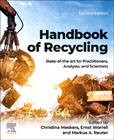
Handbook of Recycling: State-of-the-art for Practitioners, Analysts, and Scientists
Meskers, Christina
Worrell, Ernst
Reuter, Markus A.
Handbook of Recycling, Second Edition, Winner of the International Solid Waste Association's 2014 Publication Award, is an authoritative review of the current state of recycling, reuse and reclamation processes commonly implemented today and how they interact with one another. Fully updated to cover recent developments in the field, this second edition has also been restructured to cover General Aspects of Recycling, Applications, Technology, Recovery and Collection, Economics, Governance and Policy. Two new appendices have been added (Material Flow Analysis and Process Simulation), as well as several new chapters on global recycled material floa The book concludes with a review of the policy and economic implications, including the impact of recycling on energy use, sustainable development and the environment. This book is a crucial aid to students and researchers in a range of disciplines, from materials and environmental science to public policy studies. Uses examples from current professional and industrial practice in concert with policy and economic implications Portrays recent and emerging technologies in metal recycling, by-product utilization and management of post-consumer waste Uses process and system simulation as well as lifecycle analysis to show how to reclaim valuable resources from products, scraps, residues, wastes INDICE: Part 1 - Recycling in context 1. Introduction 2. Resource efficency and recycling 3. Maps of the physical economy to inform sustainability strategies 4. Material efficiency: squaring the circular economy 5. Material management strategies: recycling is the answer? 6. DfR and material & product-perspective recycling 7. Developments in municipal waste collection 8. Developments in informal recycling Part 2 - Recycling from a product perspective 9. Physical separation 10. Sensor-based sorting 11. Mixed bulky waste 12. Packaging 13. Vehicles (ELV) 14. Electric and electronic equipment (WEEE) 15. Energy generation and storage equipment 16. Buildings 17. Construction and demolition 18. Industrial by-products 19. Mine tailings Part 3 - Recycling from a material perspective 20. Steel 21. Aluminium and magnesium 22. Copper 23. Lead 24. Zinc 25. Ferroalloys 26. Precious & others metals 27. Semiconductor metals 28. Rare earth elements 29. Concrete and aggregates 30. Cementitious binders incorporating residues 31. Glass 32. Lumber 33. Paper 34. Plastic 35. Black rubber products 36.Textile 37. Carbon fibers Part 4 - Recycling and the circular economy 38. From Waste management to circular economy policy 39. Geopolitical aspects 40. Communication instruments 41. Regulatory instruments 42. Extended producer responsibility 43. Economic drivers and valuation 44. Economic policy instruments 45. Economic aspects of metal recycling Appendices: Recycling fundamentals A. Definitions & terminology B. Physical separation C. Thermodynamics D. Mass flow analysis (MFA) E. Exergy (quantification of resource dissipation) F. Process simulation G. Life cycle analysis (LCA)
- ISBN: 978-0-323-85514-3
- Editorial: Elsevier
- Encuadernacion: Rústica
- Páginas: 684
- Fecha Publicación: 01/10/2022
- Nº Volúmenes: 1
- Idioma: Inglés
